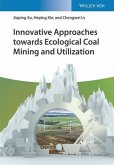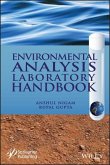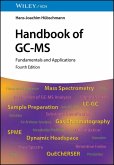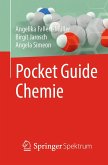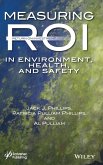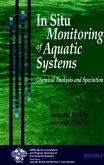- Gebundenes Buch
- Merkliste
- Auf die Merkliste
- Bewerten Bewerten
- Teilen
- Produkt teilen
- Produkterinnerung
- Produkterinnerung
Provides a guide and reference for applying spectroscopic, microscopic and mass-spectrometric techniques in the field of environmental research.
Andere Kunden interessierten sich auch für
![Innovative Approaches towards Ecological Coal Mining and Utilization Innovative Approaches towards Ecological Coal Mining and Utilization]() Jiuping XuInnovative Approaches towards Ecological Coal Mining and Utilization162,00 €
Jiuping XuInnovative Approaches towards Ecological Coal Mining and Utilization162,00 €![Environmental Analysis Laboratory Handbook Environmental Analysis Laboratory Handbook]() Anshul NigamEnvironmental Analysis Laboratory Handbook210,99 €
Anshul NigamEnvironmental Analysis Laboratory Handbook210,99 €![Handbook of Cyanobacterial C Handbook of Cyanobacterial C]() Handbook of Cyanobacterial C206,99 €
Handbook of Cyanobacterial C206,99 €![Handbook of GC-MS Handbook of GC-MS]() Hans-Joachim HübschmannHandbook of GC-MS160,99 €
Hans-Joachim HübschmannHandbook of GC-MS160,99 €![Pocket Guide Chemie Pocket Guide Chemie]() Angelika Fallert-MüllerPocket Guide Chemie24,99 €
Angelika Fallert-MüllerPocket Guide Chemie24,99 €![Measuring Roi in Environment, Health, and Safety Measuring Roi in Environment, Health, and Safety]() Jack J. PhillipsMeasuring Roi in Environment, Health, and Safety90,99 €
Jack J. PhillipsMeasuring Roi in Environment, Health, and Safety90,99 €![In Situ Monitoring of Aquatic Systems In Situ Monitoring of Aquatic Systems]() Jacques Buffle / George Horvai (Hgg.)In Situ Monitoring of Aquatic Systems646,99 €
Jacques Buffle / George Horvai (Hgg.)In Situ Monitoring of Aquatic Systems646,99 €-
-
-
Provides a guide and reference for applying spectroscopic, microscopic and mass-spectrometric techniques in the field of environmental research.
Produktdetails
- Produktdetails
- Verlag: Wiley-VCH
- Artikelnr. des Verlages: 1135441 000
- 1. Auflage
- Seitenzahl: 224
- Erscheinungstermin: 27. August 2025
- Englisch
- Abmessung: 244mm x 170mm
- ISBN-13: 9783527354412
- ISBN-10: 3527354417
- Artikelnr.: 73459770
- Herstellerkennzeichnung
- Wiley-VCH GmbH
- Boschstraße 12
- 69469 Weinheim
- wiley.buha@zeitfracht.de
- Verlag: Wiley-VCH
- Artikelnr. des Verlages: 1135441 000
- 1. Auflage
- Seitenzahl: 224
- Erscheinungstermin: 27. August 2025
- Englisch
- Abmessung: 244mm x 170mm
- ISBN-13: 9783527354412
- ISBN-10: 3527354417
- Artikelnr.: 73459770
- Herstellerkennzeichnung
- Wiley-VCH GmbH
- Boschstraße 12
- 69469 Weinheim
- wiley.buha@zeitfracht.de
Lin Du is currently Professor at the Environment Research Institute, Shandong University, China. After receiving his Ph.D from the Institute of Chemistry, Chinese Academy of Sciences, in 2008, he earned two postdoctoral fellowship positions in the Department of Chemistry, Ku Leuven, Belgium (2008-2010) and at the Center for Atmospheric Research at the University of Copenhagen, Denmark (2010-2013), and an Assistant Professorship position at the University of Copenhagen (2014) before joining Shandong University, China as a professor (2014). His research interests include secondary organic aerosol chemistry and physical and chemical properties of marine aerosols. Professor Du became a member of the scientific steering committee of International Global Atmospheric Chemistry (IGAC) in 2024. Narcisse Tsona Tchinda is currently Associate professor at the Environmental Research Institute, Shandong University, China. After his PhD degree obtained from the Division of Atmospheric Sciences, Department of Physics, University of Helsinki, Finland, in 2016, he joined Shandong University, where he earned two postdoctoral positions. His research interest is the study of the early stages of atmospheric new particle formation from gas-phase vapors and the chemistry of environmental pollutants.
1. Infrared Spectroscopy and Its Application in Atmospheric Research
1.1 Basic Theories
1.2 Infrared Spectroscopic Techniques and Principles
1.3 Experimental Facility
1.4 Applications of Infrared Spectroscopy in Atmospheric Research
1.5 Summary
2. Raman Spectroscopy and Its Application in Atmospheric Research
2.1 Basic Theories and Principles
2.2 Main types of Raman Spectroscopic Techniques
2.3 Experimental Facility
2.4 Applications of Raman Spectroscopy in Atmospheric Research
2.5 Summary
3. Ultraviolet-Visible Absorption Spectroscopy and Its Application in Atmospheric Research
3.1 Overview
3.2 Basic Principle of UV-Vis Absorption Spectroscopy
3.4 Applications of UV-vis Absorption Spectroscopy in Atmospheric Research
3.5 Summary
4. Fluorescence Spectroscopy and Its Application in Atmospheric Research
4.1 Overview
4.2 Basic Principle of Molecular Fluorescence
4.3 Experimental Facility
4.4 Application of Fluorescence Spectroscopy in Atmospheric Research
4.5 Summary
5. Optical Microscopy, Electron Microscopy and Atomic Force Microscope - Application in Atmospheric Research
5.1 Introduction
5.2 Classification and Working Principles of Microscopes
5.3 Experimental Facility
5.4 Application of Microscopic Techniques in Environmental Research
5.5 Summary
6. Mass Spectrometry and Its Application in Atmospheric Research
6.1 Introduction
6.2 Principles of Mass Spectrometers
6.3 Experimental Facility
6.4 Applications of Mass Spectrometry in Atmospheric Research
6.5 Summary
1.1 Basic Theories
1.2 Infrared Spectroscopic Techniques and Principles
1.3 Experimental Facility
1.4 Applications of Infrared Spectroscopy in Atmospheric Research
1.5 Summary
2. Raman Spectroscopy and Its Application in Atmospheric Research
2.1 Basic Theories and Principles
2.2 Main types of Raman Spectroscopic Techniques
2.3 Experimental Facility
2.4 Applications of Raman Spectroscopy in Atmospheric Research
2.5 Summary
3. Ultraviolet-Visible Absorption Spectroscopy and Its Application in Atmospheric Research
3.1 Overview
3.2 Basic Principle of UV-Vis Absorption Spectroscopy
3.4 Applications of UV-vis Absorption Spectroscopy in Atmospheric Research
3.5 Summary
4. Fluorescence Spectroscopy and Its Application in Atmospheric Research
4.1 Overview
4.2 Basic Principle of Molecular Fluorescence
4.3 Experimental Facility
4.4 Application of Fluorescence Spectroscopy in Atmospheric Research
4.5 Summary
5. Optical Microscopy, Electron Microscopy and Atomic Force Microscope - Application in Atmospheric Research
5.1 Introduction
5.2 Classification and Working Principles of Microscopes
5.3 Experimental Facility
5.4 Application of Microscopic Techniques in Environmental Research
5.5 Summary
6. Mass Spectrometry and Its Application in Atmospheric Research
6.1 Introduction
6.2 Principles of Mass Spectrometers
6.3 Experimental Facility
6.4 Applications of Mass Spectrometry in Atmospheric Research
6.5 Summary
1. Infrared Spectroscopy and Its Application in Atmospheric Research
1.1 Basic Theories
1.2 Infrared Spectroscopic Techniques and Principles
1.3 Experimental Facility
1.4 Applications of Infrared Spectroscopy in Atmospheric Research
1.5 Summary
2. Raman Spectroscopy and Its Application in Atmospheric Research
2.1 Basic Theories and Principles
2.2 Main types of Raman Spectroscopic Techniques
2.3 Experimental Facility
2.4 Applications of Raman Spectroscopy in Atmospheric Research
2.5 Summary
3. Ultraviolet-Visible Absorption Spectroscopy and Its Application in Atmospheric Research
3.1 Overview
3.2 Basic Principle of UV-Vis Absorption Spectroscopy
3.4 Applications of UV-vis Absorption Spectroscopy in Atmospheric Research
3.5 Summary
4. Fluorescence Spectroscopy and Its Application in Atmospheric Research
4.1 Overview
4.2 Basic Principle of Molecular Fluorescence
4.3 Experimental Facility
4.4 Application of Fluorescence Spectroscopy in Atmospheric Research
4.5 Summary
5. Optical Microscopy, Electron Microscopy and Atomic Force Microscope - Application in Atmospheric Research
5.1 Introduction
5.2 Classification and Working Principles of Microscopes
5.3 Experimental Facility
5.4 Application of Microscopic Techniques in Environmental Research
5.5 Summary
6. Mass Spectrometry and Its Application in Atmospheric Research
6.1 Introduction
6.2 Principles of Mass Spectrometers
6.3 Experimental Facility
6.4 Applications of Mass Spectrometry in Atmospheric Research
6.5 Summary
1.1 Basic Theories
1.2 Infrared Spectroscopic Techniques and Principles
1.3 Experimental Facility
1.4 Applications of Infrared Spectroscopy in Atmospheric Research
1.5 Summary
2. Raman Spectroscopy and Its Application in Atmospheric Research
2.1 Basic Theories and Principles
2.2 Main types of Raman Spectroscopic Techniques
2.3 Experimental Facility
2.4 Applications of Raman Spectroscopy in Atmospheric Research
2.5 Summary
3. Ultraviolet-Visible Absorption Spectroscopy and Its Application in Atmospheric Research
3.1 Overview
3.2 Basic Principle of UV-Vis Absorption Spectroscopy
3.4 Applications of UV-vis Absorption Spectroscopy in Atmospheric Research
3.5 Summary
4. Fluorescence Spectroscopy and Its Application in Atmospheric Research
4.1 Overview
4.2 Basic Principle of Molecular Fluorescence
4.3 Experimental Facility
4.4 Application of Fluorescence Spectroscopy in Atmospheric Research
4.5 Summary
5. Optical Microscopy, Electron Microscopy and Atomic Force Microscope - Application in Atmospheric Research
5.1 Introduction
5.2 Classification and Working Principles of Microscopes
5.3 Experimental Facility
5.4 Application of Microscopic Techniques in Environmental Research
5.5 Summary
6. Mass Spectrometry and Its Application in Atmospheric Research
6.1 Introduction
6.2 Principles of Mass Spectrometers
6.3 Experimental Facility
6.4 Applications of Mass Spectrometry in Atmospheric Research
6.5 Summary


